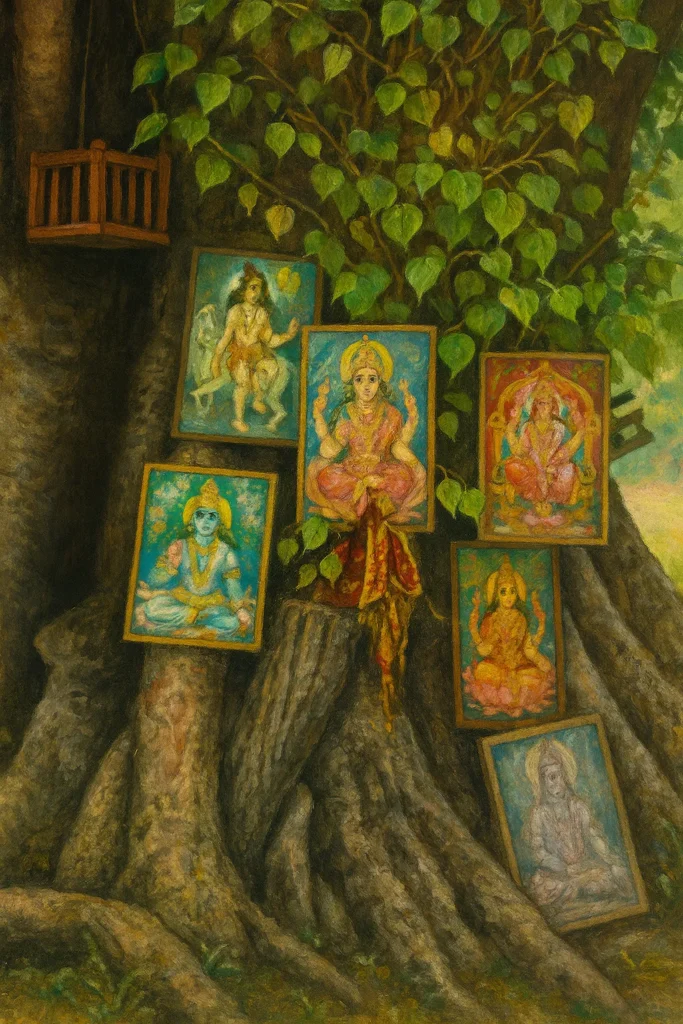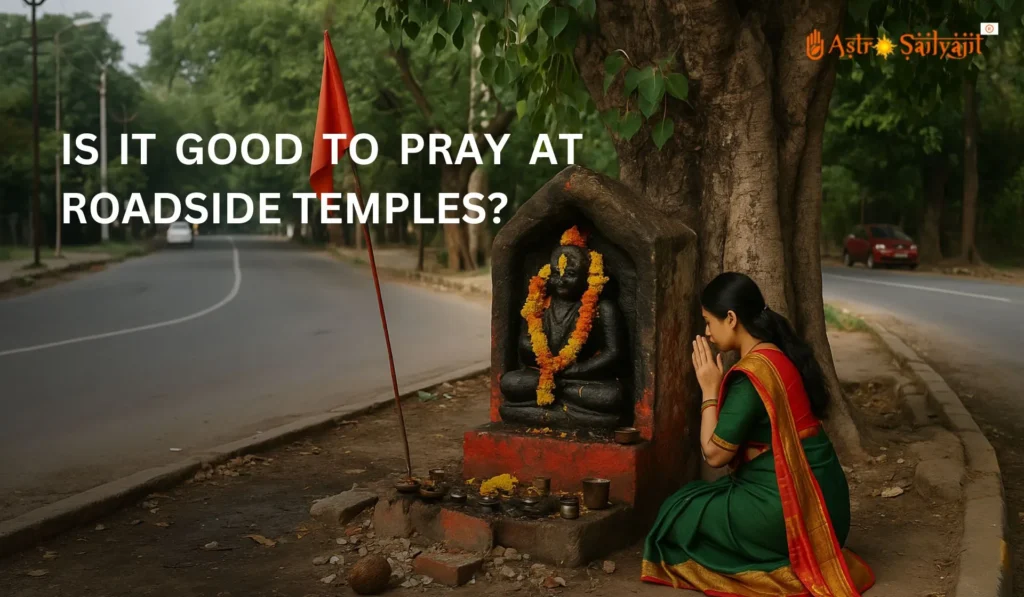“Not all temples are sanctuaries. Some are traps.”
In the hustle and chaos of Indian streets, we often pass by small temples nestled under peepal trees, perched at T-junctions, or carved hastily into footpaths. These shrines—dedicated to deities like Shani Dev, Bhairav, Kali, or even local spirits—are places where people stop to fold their hands quickly, break a coconut, light oil, or offer mustard seeds. But what if this humble act of devotion could become the invitation to your own misfortune?

This is not just a tale of superstition. Religious Vastu Shastra, Agama Scriptures, and Tantra texts reveal an unsettling truth—when divine energy is installed incorrectly, it doesn’t attract blessings. It attracts ruin.
What Makes a Temple Auspicious?
A true temple is not just a structure; it is a living energy field, aligned with cosmic forces. For a temple to emit positive vibrations, it must be:
- Built as per Agama Shastras (temple architecture principles).
- Aligned with the Vastu Purusha Mandala—the sacred energy grid.
- Consecrated through Prana Pratishtha, where the deity is invoked with mantras and sacred rites.
- Maintained with ritual purity, cleanliness, and daily worship.
When these factors are absent, the site may harbor negative energies, astral entities, and curses.
The Dark Reality of Roadside Shani Dev Shrines
Let us take a common example—the footpath shrine of Shani Dev.
Shani (Saturn) is not a wrathful god but a strict karmic teacher. He brings justice, delay, discipline, sorrow, and spiritual transformation. He demands clean energy, truth, and devotion without fear or greed.
But most roadside Shani temples are:
- Unconsecrated and installed by unknown hands.
- Surrounded by filth, traffic fumes, and leftover offerings.
- Placed on energetically unstable Vastu points, like T-junctions (Veethi Shula) or sewer-laced footpaths.
- Visited by people who come only in distress, releasing fear and negativity into the shrine.
Over time, these shrines accumulate toxic astral vibrations, becoming hotspots of sorrow, delays, accidents, and misfortune.
Religious Vastu Shastra: Red Flags for Temple Placement
According to temple and religious Vastu, the following are inauspicious signs that warn you to stay away:
Temples at T-Junctions:
This is a Raahu-Sthana—where energy collides violently. It leads to:
- Accidents.
- Mental imbalance.
- Unexpected job losses or divorces.
Broken or Uncovered Idols:
A deity whose limbs are broken, or whose idol is exposed to harsh elements, is no longer divine. It becomes a preta-vessel—a shell that attracts wandering spirits and demonic energy.
Shrines Under Banyan/Peepal Without Rituals:
Tree deities are guardian spirits, but they must be pacified with proper rituals. Randomly installing a deity under a tree can invoke bhuta and pisacha energies.
Drain, Dirt, and Disrespect:
If a temple is near a drain, garbage dump, or used to discard stale food, run. The aura is corrupted. Instead of grace, you absorb:
- Aura leakage.
- Aura possession.
- Generational karma blocks.
Spiritual Consequences of Praying at Inauspicious Temples
The Curse of Unclean Worship:
You think you’re asking for blessings. But what you receive is:
- Recurring illnesses.
- Obstacles in every new beginning.
- Sudden hatred or betrayal from close ones.
- Loss of respect in society.
- Night terrors or shadowy dreams.
Why? Because the gods are not present. What you’re worshipping is an empty throne occupied by something else.
A Real-Life Example: The Shani Curse at Dadar Footpath, Mumbai
In Mumbai, a famous Shani shrine sits under a peepal tree near a T-junction. Devotees line up to offer oil every Saturday. Yet, local shopkeepers whisper tales of:
- A businessman who lost his fortune days after offering a 1-liter oil bottle.
- A child who died in an accident after his mother prayed there for protection.
- Repeated vehicle crashes right near the shrine.
Astrologers confirmed the area sits on a Vastu Veethi Shula and a ghost path (preta yoni rekha)—a combination that invites Shani’s harshest forms, not his blessings.
Why It Happens: The Metaphysical Truth
When energy is invoked improperly, it becomes asura tattva—dark masculine energy without direction. It feeds off the fear of devotees and binds their aura to that shrine. Like a debt.
You start visiting again and again, hoping for relief. But you’re only digging your own energetic grave.
How to Protect Yourself
If you’ve prayed at such a shrine unknowingly, take action now.
Perform Shuddhi:
- Take a rock salt bath for 11 days.
- Light a sesame oil lamp at home with a clean, dedicated altar.
- Chant the Shani Beej Mantra: “Om Praam Preem Praum Sah Shanishcharaya Namah” daily.
Visit Only Authentic Temples:
- Choose temples with established prana-pratishtha.
- Avoid deities with broken eyes or limbs.
- Stay away from roadside, abandoned, or fear-ridden shrines.
Energize Your Home:
Keep a Shani Yantra, blessed by a guru, in your West zone as per Vastu. Offer black sesame, oil, and blue flowers every Saturday.
Temples Are Gateways: Not All Are to Heaven
The Vedas say:
“Yatra Devata Nivasati, Tatra Vastu Nirnayati.”
Where the deity resides, Vastu determines the outcome.
Without Vastu, a temple is just a vessel—and empty vessels invite something else to sit upon the throne. Not the god you imagined. Sometimes, it’s your worst nightmare.
Final Warning: Worship Wisely
Before you fold your hands next time at a street-side deity, ask yourself:
“Is this place radiating divine peace, or is it absorbing your fears?”
Some temples offer salvation.
Others bind your soul in invisible chains.
Acharya Sailyajit
Founder—Sailyajit Vastu & Interior Consulting
Guwahati | Serving India & Beyond
📞 +91-6003937773
FAQs
Q1: What is a roadside shrine?
A roadside shrine is a small temple or deity idol installed along streets, under trees, or near T-junctions, often worshipped by passersby without formal rituals or consecration.
Q2: Is it safe to worship at a roadside shrine?
According to Vastu Shastra, not all roadside shrines are safe. Improper placement and lack of rituals can attract negative energies instead of blessings.
Q3: Why are roadside shrines considered inauspicious in Vastu?
Roadside shrines, especially those at T-junctions or near drains, are often placed on Vastu-sensitive spots like Veethi Shula, which can lead to mental distress, accidents, and aura imbalance.
Q4: Can a roadside shrine bring bad luck?
Yes, if a roadside shrine is neglected, broken, or energetically unstable, it may channel negative karmic energy, causing misfortune, delays, or emotional turmoil.
Q5: How do I cleanse myself after visiting a negative roadside shrine?
Perform a rock salt bath, light a sesame oil lamp at home, and chant protective mantras like the Shani Beej Mantra to purify your energy.
Q6: Is it good to pray at a roadside temple?
While it may seem devotional, Vastu experts caution against praying at roadside temples that are unconsecrated or poorly maintained. These shrines may attract negative energies if not built according to sacred principles, potentially causing more harm than good.











